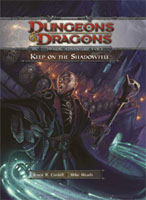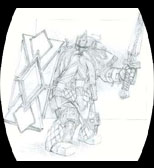 I thought I was done talking about Keep on the Shadowfell for a bit, but as I was prepping the adventure yesterday I had some interesting thoughts that I felt like sharing. These should give you some insight not only into how I go about prepping an adventure, but also how I analyze game design issues (both in the design of the system and in the design of the scenario).
I thought I was done talking about Keep on the Shadowfell for a bit, but as I was prepping the adventure yesterday I had some interesting thoughts that I felt like sharing. These should give you some insight not only into how I go about prepping an adventure, but also how I analyze game design issues (both in the design of the system and in the design of the scenario).
DWARF FIGHTER
Let’s start by looking at the pregenerated fighter character. As most of you probably already know, there are basically three different kinds of abilities in 4th Edition: At-will abilities (which can be used as often as you like); Encounter abilities (which require a short rest to recharge); and Daily abilities (which require an extended rest to recharge).
(Some at-will abilities will also recharge irregularly or in response to conditions on the battlefield.)
I’ve been kinda thinking of these different abilities like this: At-will abilities are the ones which define your character; encounter abilities are nifty; and daily abilities are awesome.
With that in mind, let’s take a look at the at-will abilities that the pregenerated dwarf fighter has at 1st level: Cleave and reaping strike.
CLEAVE – Fighter Attack 1
You hit one enemy, then cleave into another.
At-Will – Martial, Weapon
 Standard Action – Melee weapon
Standard Action – Melee weapon
Target: One creature
Attack: +6 vs. AC
Hit: 2d6+3 damage, and an enemy adjacent to you takes 3 damage.
REAPING STRIKE – Fighter Attack 1
You punctuate your scything attacks with wicked jabs and small cutting blows that slip through your enemy’s defenses.
At-Will – Martial, Weapon
Standard Action – Melee weapon
Target: One creature
Attack: +6 vs. AC
Hit: 2d6+3 damage
Miss: 3 damage
I’m very impressed by the ways in which the utility of these abilities interlock with each other.
First, there is the obvious situational advantage: Cleave is going to be preferable when you’re standing in the middle of a minion mob; reaping strike is going to be useful when you’re facing off against a single opponent.
But, there’s also another trade-off point that happens because reaping strike is more useful than cleave when an opponent becomes sufficiently difficult to hit. Here’s the math:
The average expected damage per round for cleave is:
(3.5 + 3.5 + 3 + 3 = 13) x probability to hit + (0 x probability to miss)
The average expected damage per round for reaping strike is:
(3.5 + 3.5 + 3 = 10) x probability to hit + (3 x probability to miss)
If the probability to hit is 50/50, for example, then you end up with cleave doing an average of (13 x 50%) 6.5 points of damage per round and reaping strike doing an average (10 * 50% + 3 * 50%) 6.5 points of damage per round.
So if my math here is correct, reaping strike is going to deal more damage to your opponents in any situation where you have to roll a natural 12 or higher to hit. (With a slight hiccup because minions aren’t affected by missed attack damage like reaping strike.)
On the one hand, I’m impressed by how two distinctive fighting styles emerge quite naturally out of these probabilities. When you’re using cleave you’re swinging away like wild because your significantly superior to your opponents (you have a 50/50 or better shot of hitting them); in the other you’re performing a variety of jabs and cutting blows against a more skilled opponent, trying to find the weakest spots in his defense.
On the other hand, I’m impressed because of the meaningful tactical choice that these interlocking utilities give you. Either utility, by itself, doesn’t constitute a meaningful tactical choice: If one ability is merely better against multiple opponents and the other is better against solitary opponents, there’s no meaningful choice to be made. If you’re fighting multiple opponents you’d use cleave and if you’re fighting a single opponent you’d use reaping strike.
Similarly, if one ability was merely better against difficult-to-hit opponents and the other was better against easy-to-hit opponents, there’s no meaningful choice to be made. If you’re fighting difficult-to-hit opponents you’ll use reaping strike and if you’re fighting easy-to-hit opponents you’d use cleave.
But once you combine the two, meaningful choices emerge. There will still be times when the decision basically boils down to running the math and figuring out what your best expected damage is, but in most situations involving multiple foes you’ll actually be making a meaningful choice about what your immediate goal is and how you want to pursue it. (I also have a fair degree of confidence that, as tactical choices proliferate at higher levels, these choices will become increasingly non-trivial.)
Now, there is one caveat to this, which is that the minion rules pretty much muck it up.
For one example of this, let’s look at reaping strike: Because minions never suffer damage from missed attacks, reaping strike is completely useless against minions. So if you’re trying to hit a minion, there will never be any conceivable benefit to using reaping strike. The tactical choice has once again been rendered completely moot.
On other hand, if minions were damaged — and, thus, killed — by missed attacks, the tactical choice between cleave and reaping strike is meaningful: Do you use reaping strike for a guaranteed kill on one minion or do you use cleave for a chance to kill two minions? It becomes a trivial decision when you’re only facing off against a single minion, of course (since cleave has no advantage over reaping strike) — but that’s true of any situation when you’re facing off against a single opponent and minions are designed to come in large numbers.
(Of course, this change would make reaping strike more effective on average. And I hardly know enough about the complete panoply of 4th Edition abilities to know what other effects such a change might have.)
But, overall, these are well-designed abilities that give rise to a well-designed character. It’ll be interesting to see what the other 1st level fighter abilities are and how they interact with cleave and reaping strike.












